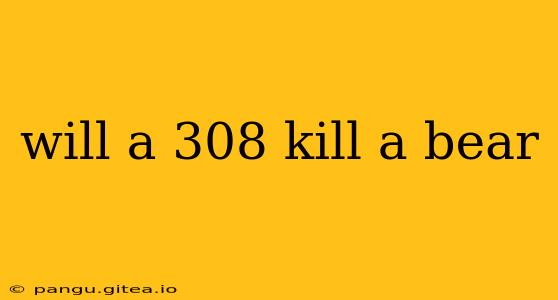The question, "Will a .308 kill a bear?" is a serious one, sparking debate among hunters and survivalists alike. The short answer is: potentially, yes, but it's far more nuanced than that. The effectiveness of a .308 Winchester against a bear depends on several crucial factors, and relying solely on the caliber is a dangerous oversimplification.
Factors Affecting the Lethality of a .308 on a Bear
Several key elements determine whether a .308 round will successfully stop a charging bear:
1. Shot Placement: Accuracy is Paramount
This is arguably the most important factor. Even the most powerful cartridge is ineffective with poor shot placement. A .308 needs to hit vital organs – the heart, lungs, or brain – to quickly incapacitate a bear. A glancing blow to the leg, for example, will likely only enrage the animal, putting you in even greater danger. Precise, accurate shooting is paramount.
2. Bear Size and Species: A Significant Variable
Bear size and species drastically affect the outcome. A smaller black bear will be more susceptible to a well-placed .308 shot than a massive grizzly or Kodiak bear. Larger bears possess significantly more mass and tougher hides, demanding more powerful ammunition or multiple well-placed shots for effective stopping power.
3. Ammunition Selection: Bullet Type Matters
The type of ammunition used significantly impacts the .308's effectiveness. Expanding bullets, designed to mushroom upon impact, transfer more energy and cause greater tissue damage than full metal jacket (FMJ) rounds. Choosing the right ammunition specifically designed for large game hunting is crucial. Consult with experienced hunters and firearm professionals for advice on selecting appropriate ammunition for bear defense.
4. Shooter Proficiency: Training and Experience are Key
A skilled marksman can make a .308 significantly more lethal than an inexperienced shooter. Proper training, practice, and understanding of firearm safety and handling are essential, especially in high-stress situations like a bear encounter. Regular practice with your specific firearm and ammunition is critical.
5. Distance: Effective Range Considerations
The effective range of a .308 varies depending on the ammunition and firearm used. Accuracy diminishes significantly beyond a certain distance. Attempting a long-range shot on a bear could result in a less-than-lethal hit and an enraged animal. Knowing the limitations of your firearm and choosing your engagement range wisely is paramount.
Alternatives and Best Practices for Bear Encounters
While a .308 can be used effectively for bear defense, it's not a guaranteed solution. Other calibers, like the .375 H&H Magnum or larger, are generally considered more suitable for large bears.
Crucially, bear spray is often considered the first line of defense against aggressive bears. It's lightweight, easier to deploy, and has a significantly higher success rate than firearms in many situations.
Always prioritize prevention:
- Make noise while hiking: Bears generally want to avoid human contact.
- Carry bear spray: Familiarize yourself with its proper use.
- Travel in groups: Bears are less likely to attack larger groups.
- Store food properly: Secure all food and scented items.
- Be aware of your surroundings: Observe for signs of bear activity.
Conclusion: Responsible Bear Defense
The .308 can be a part of a responsible bear defense strategy, but it's not a foolproof solution. Success hinges on accurate shot placement, proper ammunition selection, shooter proficiency, understanding the limitations of the caliber, and most importantly, minimizing encounters through responsible behavior in bear country. Always prioritize safety and seek expert advice on bear defense techniques and firearm usage. Remember, prevention is the best defense.
